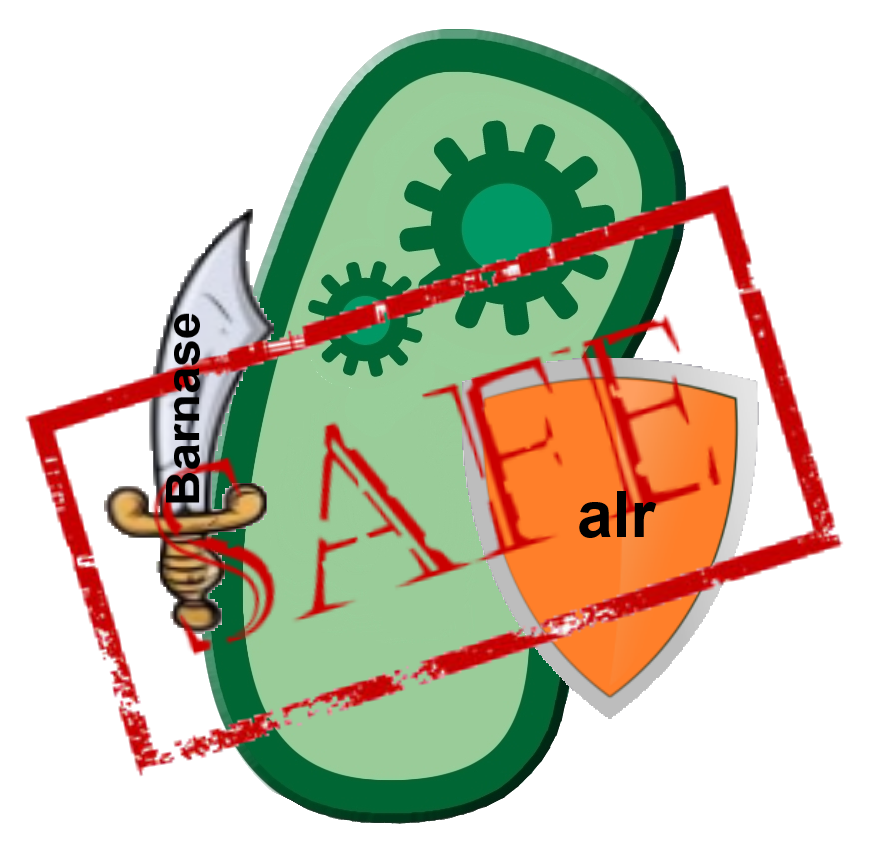Team:Bielefeld-Germany/Biosafety/Biosafety System
From 2013.igem.org
| Line 73: | Line 73: | ||
For this approach we combined two common Biosafety-ideas, an auxotrophy and a toxic gene product, in one device. So the constructed Biosafety-System takes the best of this two approaches and is characterized by a double kill-swtich system. This double kill-switch mechanism provides additional a higher plasmid stability and a higher resistance towards undesirable mutations. In one sentence: Our Biosafety-System is safe! | For this approach we combined two common Biosafety-ideas, an auxotrophy and a toxic gene product, in one device. So the constructed Biosafety-System takes the best of this two approaches and is characterized by a double kill-swtich system. This double kill-switch mechanism provides additional a higher plasmid stability and a higher resistance towards undesirable mutations. In one sentence: Our Biosafety-System is safe! | ||
</p> | </p> | ||
| - | |||
| - | |||
| - | |||
| - | |||
| - | |||
| - | |||
| Line 86: | Line 80: | ||
==Theory== | ==Theory== | ||
| - | + | Our three biosafety systems are all based on an induced repressor system. As shown in the illustration below an inducer activates a promoter which expresses the repressor gene which delays a second promoter in front of a gene. This inducer can be a substrate like L-rhamnose or a product which the organism produces and delays the expression of a gene. This is an advantage because the organism only produces products when it is necessary so the metabolic stress is lower. This delay can be executed in different ways. For example the repressor araC in our [https://2013.igem.org/Team:Bielefeld-Germany/Biosafety/Biosafety_System_S araCtive] system regulates negatively the pBAD promoter by building up a dimer, which builds a DNA loop and inhibits the binding of the RNA-polymerase. So this example stands for a structural change of the DNA. This function can be found in our [https://2013.igem.org/Team:Bielefeld-Germany/Biosafety/Biosafety_System_L Lac of Growth] system. | |
| - | + | <br> | |
| - | + | Another example for a second way the repressor acts is a direct interaction between the repressor and the operator. The repressor and the operator build a complex which the RNA polymerase can’t overcome. So the repressor blocks the RNA polymerase. | |
| - | + | ||
| - | + | ||
| - | + | ||
| - | + | ||
| - | + | ||
| - | + | ||
| - | + | ||
| - | + | ||
| - | + | ||
| - | + | ||
| - | + | ||
| - | + | ||
| - | [ | + | |
| - | + | ||
| - | + | ||
| - | + | ||
| - | + | ||
| - | + | ||
| - | + | ||
| - | + | ||
| - | + | ||
| - | + | ||
| - | + | ||
| - | + | ||
| - | + | ||
| - | + | ||
| - | + | ||
| - | + | ||
| - | [[File:IGEM Bielefeld 2013 Biosafety | + | [[File:IGEM Bielefeld 2013 Biosafety allg. Repressor 2.png|600px|thumb|center|FigureX: General illustration of the repressor activity.]] |
==Results== | ==Results== | ||
Revision as of 10:47, 4 October 2013
Biosafety System
Overview
Biosafety is an essential aspect when taking part in iGEM especially when you work with living organisms which could possibly get out of your application by damage or incorrect handling. In order to counter this problem there exist useful systems to prevent the bacteria from escaping or killing the bacteria when they are outside of the application. To complement this archive we constructed not only one system but also three systems which differ in leakiness and strength. For this approach we combined two common Biosafety-ideas, an auxotrophy and a toxic gene product, in one device. So the constructed Biosafety-System takes the best of this two approaches and is characterized by a double kill-swtich system. This double kill-switch mechanism provides additional a higher plasmid stability and a higher resistance towards undesirable mutations. In one sentence: Our Biosafety-System is safe!
Theory
Our three biosafety systems are all based on an induced repressor system. As shown in the illustration below an inducer activates a promoter which expresses the repressor gene which delays a second promoter in front of a gene. This inducer can be a substrate like L-rhamnose or a product which the organism produces and delays the expression of a gene. This is an advantage because the organism only produces products when it is necessary so the metabolic stress is lower. This delay can be executed in different ways. For example the repressor araC in our araCtive system regulates negatively the pBAD promoter by building up a dimer, which builds a DNA loop and inhibits the binding of the RNA-polymerase. So this example stands for a structural change of the DNA. This function can be found in our Lac of Growth system.
Another example for a second way the repressor acts is a direct interaction between the repressor and the operator. The repressor and the operator build a complex which the RNA polymerase can’t overcome. So the repressor blocks the RNA polymerase.
Results
References
- Autoren (Jahr) Titel [Link|Paper Ausgabe: Seiten].
Contents |
 "
"


